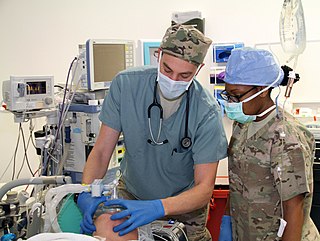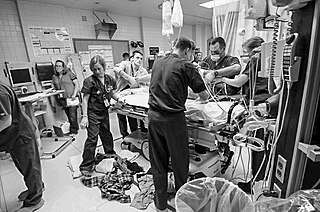
In the medical profession, a general practitioner (GP) is a medical doctor who treats acute and chronic illnesses and provides preventive care and health education to patients.
Osteopathic medicine is a branch of the medical profession in the United States. Osteopathic doctors (DOs) can be licensed to practice medicine and surgery in all 50 states and are recognized to varying degrees in 65 other countries.

Anesthesiology, anaesthesiology, anaesthesia or anaesthetics is the medical speciality concerned with the total perioperative care of patients before, during and after surgery. It encompasses anesthesia, intensive care medicine, critical emergency medicine, and pain medicine, with the study and use of anesthesia and anesthetics being its core element. A physician specialised in this field of medicine is called an anesthesiologist, anaesthesiobblogist or anaesthetist, depending on the country.
A Physician Assistant (PA) is a professional who practices medicine in collaboration or under indirect supervision of a physician, depending on state laws. Physicians do not need to be on-site with PAs and collaboration or supervision often occurs via electronic means when consults are necessary. Their scope of practice varies by jurisdiction and healthcare setting.

The Royal College of Physicians and Surgeons of Canada(Royal College) is a regulatory college which acts as a national, nonprofit organization established in 1929 by a special Act of Parliament to oversee the medical education of specialists in Canada.

The American College of Emergency Physicians (ACEP) is a professional organization of emergency medicine physicians in the United States. It is headquartered in Irving, Texas and operates an office in Washington, D.C. As of 2013, ACEP has more than 31,000 physician members.

Residency or postgraduate training is a stage of graduate medical education. It refers to a qualified physician, podiatrist, or dentist who practices medicine, usually in a hospital or clinic, under the direct or indirect supervision of a senior clinician registered in that specialty such as an attending physician or consultant. In many jurisdictions, successful completion of such training is a requirement in order to obtain an unrestricted license to practice medicine, and in particular a license to practice a chosen specialty. An individual engaged in such training may be referred to as a resident, house officer, registrar or trainee depending on the jurisdiction. Residency training may be followed by fellowship or sub-specialty training.
Family medicine (FM), formerly family practice (FP), is a medical specialty devoted to comprehensive health care for people of all ages; the specialist is named a family physician or family doctor. In Europe the discipline is often referred to as general practice and a practitioner as a general practice doctor or GP; this name emphasises the holistic nature of this speciality, as well as its roots in the family. Family practice is a division of primary care that provides continuing and comprehensive health care for the individual and family across all ages, genders, diseases, and parts of the body; family physicians are often primary care physicians. It is based on knowledge of the patient in the context of the family and the community, emphasizing disease prevention and health promotion. According to the World Organization of Family Doctors (WONCA), the aim of family medicine is to provide personal, comprehensive, and continuing care for the individual in the context of the family and the community. The issues of values underlying this practice are usually known as primary care ethics.
Medical education in the United States includes educational activities involved in the education and training of physicians in the United States, from entry-level training through to continuing education of qualified specialists.
The Accreditation Council for Graduate Medical Education (ACGME) is the body responsible for accrediting the majority of graduate medical training programs for physicians in the United States. It is a non-profit private council that evaluates and accredits medical residency and internship programs. The ACGME was founded in 1981 and was preceded by the Liaison Committee for Graduate Medical Education, which was established in 1972. The ACGME currently oversees the post-graduate education and training for all MD and the majority of DO physicians in the United States. Plans call for the ACGME to oversee the Unified Accreditation System for all MDs and DOs in 2015.

The University of Illinois College of Medicine offers a four-year program leading to the MD degree at four different sites in Illinois: Chicago, Peoria, Rockford, and formerly Urbana–Champaign. The Urbana–Champaign site stopped accepting new students after Fall 2016 to make room for the newly established Carle Illinois College of Medicine.

Oklahoma State University Medical Center is a teaching hospital with medical clinics located in Tulsa, Oklahoma. OSU medical center operates a large number of osteopathic residency and fellowship programs. The hospital is accredited by the American Osteopathic Association's Healthcare Facilities Accreditation Program.
In the United States, physicians may hold either the Doctor of Medicine degree (MD) or the Doctor of Osteopathic Medicine degree (DO). MD and DO physicians complete similar residency programs in hospitals, can be licensed in all 50 states, and have rights and responsibilities common to physicians.
Doctor of Osteopathic Medicine is a professional doctoral degree for physicians and surgeons offered by medical schools in the United States. A DO graduate may become licensed as an osteopathic physician, having equivalent rights, privileges, and responsibilities as a physician who has earned the Doctor of Medicine (MD) degree. DO physicians are licensed to practice the full scope of medicine and surgery in 65 countries, and in all 50 US states. They constitute 11% of all US physicians. As of 2018, there were more than 145,000 osteopathic medical physicians and osteopathic medical students in the United States.
The American Academy of Emergency Medicine (AAEM) is a nonprofit professional medical association of emergency medicine physicians. It was formed in 1993 is based out of Milwaukee, Wisconsin.

Joseph F. Waeckerle is an American physician specializing in Emergency and Sports medicine. He is best known to the public for directing the search and rescue efforts at the Hyatt Regency walkway collapse in Kansas City, Missouri on July 17, 1981. He is currently Clinical Professor of Emergency Medicine, University of Missouri at Kansas City School of Medicine and Editor Emeritus of Annals of Emergency Medicine. He previously served as Chief Medical Officer for the Office of Homeland Security, State of Missouri and Medical Officer for the Kansas City Division of the FBI.
Match Day is a term used widely in the graduate medical education community to represent the day when the National Resident Matching Program or NRMP releases results to applicants seeking residency and fellowship training positions in the United States. Match Day for the NRMP Main Residency Match is on the third Friday of March each year, and Match Day ceremonies occur at many of the 155 medical schools in the United States where those results are announced. Match Days for the NRMP Fellowship Matches occur throughout the year because each Fellowship Match has its own schedule of dates. Other national matching plans like the American Osteopathic Association (AOA), American Urological Association, and the San Francisco Match have dates on which they release their results. By participating in a national matching plan, applicants contractually agree to attend the residency, internship or fellowship programs to which they match. The same agreement applies to the programs; they are obligated to train the applicants who match to them. In 2017, Match Day hit a record-high as 35,969 U.S. and international medical school students and graduates vied for 31,757 residency positions.
Ronald Daniel Stewart, OC, Member of the Order of Nova Scotia, Member of the Executive Council of Nova Scotia (hon), former Minister of Health for the Province of Nova Scotia and member of the provincial parliament, was born in North Sydney, on the island of Cape Breton, Nova Scotia, and was raised in the neighbouring town of Sydney Mines. The son of a community-minded homemaking mother and a coal-miner father who entered the mines at the age of 14, his early education was obtained in local schools in which he was steeped in the classics and from an early age was expected to excel in his studies. He led his 18-member class at graduation and was awarded several scholarships to university.1 He was the first of his family to graduate from high school and the only member of his graduating class to enter university.
Pediatric emergency medicine (PEM) is a medical subspecialty of both pediatrics and emergency medicine. It involves the care of undifferentiated, unscheduled children with acute illnesses or injuries that require immediate medical attention. While not usually providing long-term or continuing care, pediatric emergency doctors undertake the necessary investigations and interventions to diagnose patients in the acute phase, to liaise with physicians from other specialities, and to resuscitate and stabilize children who are seriously ill or injured. Pediatric emergency physicians generally practice in hospital emergency departments.









